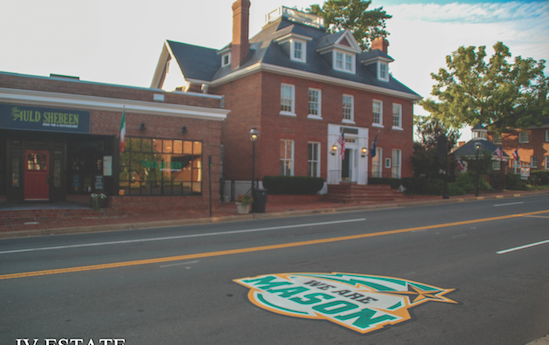City of Fairfax takes steps to embrace Mason community
As Fairfax takes steps to embrace George Mason University, questions are raised about the changing relationship between the university and the community.
When the Mason logo road decals were reported by Fourth Estate in July of this year, Jeff Greenfield, the only Mason alumni on the Fairfax City Council and the project’s facilitator, said that the designs were “one more step in furthering the relationship between the university and the city.”
Compared to other university communities, Fairfax and Mason are still in the beginning phases of establishing a college town. Many schools have had a hundred or more years to develop a culture around their institution, something that is still happening in Fairfax.
“There are these visual statements that are starting to happen,” said Traci Claar, director of Community and Local Government Relations at Mason. “Once people start to see that, we start to come together. It starts to change the perception that our culture is different from their culture…even if they were at extreme opposites at one point.”
Over the past couple of years, both Mason and the surrounding community have worked to improve communication and collaborate on projects.
In 2011, officials from Fairfax County, the City of Fairfax and Mason created the Fairfax Campus Advisory Board, a public forum where university and community officials meet to discuss issues and projects.
“We are both here to stay,” said Scott Silverthorne, mayor of the City of Fairfax. “Therefore we better figure out a way that we can work more closely together and find more ways to partner, rather than less.”
In 2012, the advisory board was used to discuss updates with Campus Drive construction and address issues brought up by the public.
In another example of increased interaction between Mason and the community, university and local elected officials visited students living off-campus to welcome them to the community and provide information on how to be “good neighbors.”
Fairfax Mayor Scott Silverthorne has met with university President Ángel Cabrera between eight and ten times since Cabrera took office in 2012.
When asked about the road decals, university and city officials will say they represent a changing relationship between the two entities.
“I think that there is a more permanent change taking place in terms of the relationship,” Claar said.
“I believe there is a new spirit of cooperation and partnership,” said Silverthorne. “All [the decals] really do is build good will,” Silverthorne said. “It’s a matter of spirit and pride. Those are the kinds of things that we should do more.”
But as Fairfax and Mason take steps to embrace one another, there have been increasing discussions about what exactly constitutes a college town.
Claar cited a definition of “college town” from an article in the Chronicle of Higher Education:
“True college towns are places where the identity of the city is both shaped by and complementary to the presence of its university, creating an environment enjoyable to all residents, whether they are enrolled in classes or not,” read the article.
Part of the discussion behind forming a college town involves how the cultures of the two communities are shaped by one another. According to Claar, as the city and Mason begin to embrace one another, people do not see Mason and Fairfax as separate entities.
Silverthorne said that there has been a lot of progress in how the university and the surrounding community interact, and that has had an impact on more negative aspects of the relationship.
“There have been some issues over the years that have built mistrust…that I think is both the city’s fault and the university’s fault,” Silverthorne said. “If you can build trust, then I think a lot of the other issues will go away.”
According to Silverthorne, forums like the advisory board or projects like the road decals are important steps to building trust.
While community and university administrators have made an effort to collaborate, some say the city is a long way from being a “college town.”
“I cannot say that we created an environment that is supportive of [a college town] yet,” Claar said.
For now, city and university officials will continue to discuss how best to communicate and collaborate on community issues.
“The first word that comes to mind is a partnership,” Silverthorne said when referring to the idea of a college town. “You have to have a friendship and a trust between the city and the university.”

